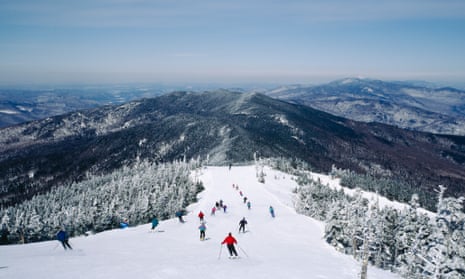Growing up near small, affordable ski resorts, I was part of a close-knit community that instilled a life-long love for winter sports for me: I learned to ski at Suicide Six in Vermont in the late 1980s; I rode my first snowboard in 1995 at Pat’s Peak, an independent resort in central New Hampshire. Fortunately, thsse small mountains are still open today – but hundreds of other small ski resorts across the United States have not been so lucky. Some folded after several consecutive years of poor or unreliable snow; others because they couldn’t keep up with the necessary snowmaking, afford the liability insurance, or compete with the offerings or prices at bigger resorts.
Light and unreliable snow has an enormous impact on the ski resorts that attract the 50-60mn skiers every year in the US and the economic significance of snowfall is clear: resorts fair much better in years with abundant natural snowfall. During the 2011-2012 winter, which saw highs of more than 80ºF in mid-March, resorts experienced a 15% drop in skier visitation compared to the previous season. Seasons like that can cost the winter tourism economy an estimated $1.1nn and 13,000-27,000 jobs.
The drastic differences in snowfall between the East and West coast mountains this winter are caused by a wavy jet stream that has led to more big snowstorms –nor’easters – along the East Coast, making this the year to ski the East. More than six feet of snow had fallen in Boston before this weekend, when it got more than another foot. Record warm sea surface temperatures off the Northeast coast are fueling moisture that is mixing with cold Arctic blasts, much to the delight of ski resorts and other winter recreation enthusiasts. By contrast, the West Coast mountains of California, Oregon and Washington are struggling to accumulate even 50% of normal snowpack thanks to the ridiculously resilient ridge (or Triple R) of high pressure that is blocking moisture from reaching the region. Colorado, meanwhile, sits at about average snowpack and a storm arrived just in time for President’s Day skiing.
Whether wavy jet streams and extreme winters will become more common in a world warmed by greenhouse gases is the subject of a very fascinating scientific debate; the precise causes of the wavy jet stream (be it more autumn snow in Siberian, Arctic sea ice extent, or warmer waters in the western equatorial Pacific to name a few hypotheses) remain unclear.
What scientists do know is that winters are warming, and a warmer atmosphere holds more moisture. A meteorological sweet spot for snow exists between 28º and 32ºF, where excess moisture can be released as abundant snowfall. Once above the freezing point, that moisture falls as rain and melts existing snowpacks – the death knell for skiing.
Mid-winter snowfall might result from slight warming, if the temperatures get closer to that “sweet spot”. However, warmer temperatures, and increased rainfall at the start and end of winter, would shorten the ski season.According to the National Ski Areas Association Kottke End of Season Reports from 2009-2011, ski resorts see as much as 20% of their skier visits in the holiday period between Christmas and the New Year’s holiday; loss of this critical early period due to rain could shake a resort’s financial foundation. Mid-winter rainfall could bring them to their knees.
Winter tourism –which is an estimated $12.2bn dollar industry – can probably weather the winter extremes while preparing for inevitably warmer winters, but it will likely come at the cost of the smaller resorts that have traditionally served as feeder programs to the sport. And, only six of the previous 19 Winter Olympic venues are expected be cold enough to host the Games by 2090. The resorts that survive will continue to adapt to warmer winters and less reliable snow by adding more summer programming, investing in ever more energy efficient technology for snowmaking and other resort operations and committing to advocating for US policy action on climate change.
As a scientist, I want to understand how climate change is impacting winter. As a skier and snowboarder for more than 20 years, I want to protect the winter sport I love from the threat of warmer winters. As a mother, I want to preserve snowy winters for my four-month-old son to someday enjoy with his own children.
But snow also provides water for drinking and irrigation, regulates climate by reflecting the sun’s energy, and supports healthy ecosystems. Cold temperatures in winter keep invasive insects and pests at bay and provide the chilling hours necessary for crops like apples and blueberries. We know that winters are warming and that we’ve already committed to more heat coming down the pipeline. We need more politicians dedicated to playing the long game on climate change, or else not being able to ski will be the least of our concerns.
